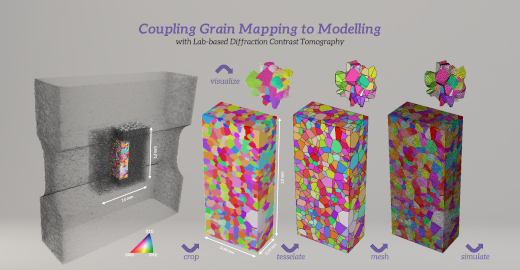
Neper pipeline for tessellating, meshing and visualizing a 3D grain map from LabDCT
Crystallographic orientations are critical in understanding the physical, chemical, and mechanical properties of materials, as well as in building models to predict how these properties evolve under external stimuli like mechanical deformation or thermal conditions. Crystal-plasticity finite-element (CP-FE) simulations offer the ability to predict how the grain structure evolves during deformation. CP-FE models can be instantiated both from synthetic random grain structures, from synthetic grain structures with tailored properties like grain size distributions and textures, and from experimentally determined grain structures.
Lab-based DCT provides a unique, non-destructive approach to determine the crystal orientations of materials experimentally. While the lab-based DCT output is a voxellated sample volume, CP-FE models typically require the simulation input to be a mesh. Several different tools exist that can be used for the meshing step. Here we demonstrate how one of these, the open source software Neper, can be used to go from a voxellated lab-based DCT grain map output from GrainMapper3D to a simulation-ready input mesh. The full pipeline instructions are available from github, while example data can be downloaded from the Materials Data Facility. The example data stems from the PhD work of Maryse Gille, Mines Paris, which can be found via the link below.
